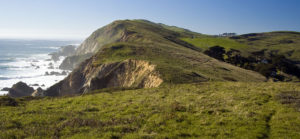Sheila Barry uses a time-honored tactic to focus on a few exceptions to invalidate generalized statements. In this case, her endorsement of livestock as a benefit (“Letter: Sheila Barry Responds to George Wuerthner“) ignores the many recognized negative impacts cows have on water quality, wildlife, plant communities, soils, and ecosystems.
Livestock production is the number one source of water pollution in the West, including in California. Most streams passing through grazed lands exceed levels of E. coli considered safe by government agencies. Livestock is a major cause of species endangerment in the western United States including California, responsible for the decline of hundreds of species. Livestock is a major source for the spread of exotic plants including the invasives that now dominate the Bay area grasslands. Livestock are the major reason we kill everything considered “pests” from grasshoppers to ground squirrels to coyotes. Livestock forage production, including the growing of exotic water-hungry plants like alfalfa, is a major cause of stream dewatering in California. Livestock are also the major source for degradation of riparian areas—the thin green lines of vegetation used by 70-80 percent of all wildlife species. Livestock transfer diseases to wildlife. And methane from livestock, including grass-fed beef, is one of the leading causes of global warming.
While the specifics will vary from region to region, the cumulative impact is similar—livestock production is one of the biggest sources of environmental degradation to be found.
To selectively cite livestock as a benefit is like saying that radiation can help to cure cancer—an accurate statement as far as it goes. However, as most folks know, radiation treatments over our bodies would be deadly. Similarly the widespread use of livestock across the landscape has proven deadly for native wildlife and ecosystems.
There may be specific localized areas where limited and targeted livestock grazing in an emergency situation might confer some very narrowly defined benefits just as targeted radiation might be the lesser of evils if one is combating cancer. However, the use of livestock, , like radiation, is a last resort measure that treats the symptoms instead of promoting a healthy ecosystem where livestock shock treatments would not be necessary.
For instance, Barry cites livestock grazing as a benefit for the Bay checkspot butterfly. The butterfly is endangered for a host of reasons which includes loss of habitat due to sprawl, and more recently, nitrogen fertilization from car exhaust that favors faster growth by invasives that is overwhelming the butterfly’s preferred native host plant species.
An additional threat are the pesticides sprayed primarily to benefit agriculture, including livestock, which poisons the butterfly’s larval stage. Over 60 pesticides are used in proximity to Bay checkerspot butterfly habitat in the Bay Area, including chlorothalonil, chlorpyrifos and diazinon.
Keep in mind that many of the invasives now overwhelming the butterfly’s primary host plants were introduced as livestock forage. Plus livestock grazing favors the continued spread of exotics because native perennial grasses are generally grazing-intolerant species. And finally the native insects like grasshoppers and others that grazed on and recycled native grasses have largely been eliminated by spray programs designed to favor livestock forage production, freeing exotics from natural control agents.
A holistic approach to the butterfly’s recovery would entail restoring native plants along with a reduction in auto emissions that favor the growth of exotics, as well as a reduction in pesticide use so that livestock grazing would not be necessary as a last ditch effort to save the butterfly.
Similarly Ms. Barry cites grazing as a way to protect communities from wildfire. This is another delusion promoted by the Ag industry. You can find research done by paid livestock proponents in range departments throughout the West that suggests grazing can reduce range fires . Yet such research ignores how livestock grazing promotes flammable species like cheatgrass by destroying biocrusts and contributing to the reduction of native perennial grasses.
Finally, our ecosystems suffer the multiple documented effects of livestock production from the compaction of soils by hooves, the spread of more exotics, the loss of hiding cover for ground nesting birds and small rodents, the reduction of vegetative cover that reduces evaporation of soil moisture, and so on.
In sum, on closer examination nearly every example given by livestock proponents to justify livestock grazing on public lands is found to be more complicated than acknowledged or could be solved without livestock grazing.




